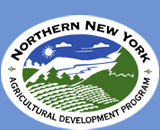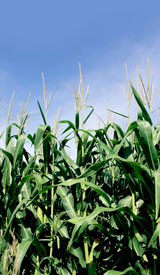March 2, 2007
Contact: Dr. Quirine
M. Ketterings, Cornell University, 607-255-3061;
NNYADP Co-Chairs Jon Greenwood, 315-386-3231; Joe Giroux, 518-563-7523
NNYADP Research Evaluating Six Ways to Help Corn Growers
Save Money, Reduce Nutrient Loss; Learn More March 14-15
The Northern New York Agricultural Development Program, a farmer-led
research and educational outreach organization for New York�s six
northernmost counties, is funding research that is evaluating six
testing tools to help producers know when nitrogen is needed for corn
crops. Cornell University researchers are working with farmers to
develop ways to assess when farmers can save the cost of applying
additional nitrogen (N), a key nutrient for corn. Reducing the amount of
N applied to corn also reduces nitrogen leaching to groundwater. Details
on this regional research will be presented at Crop Congresses in
Carthage on March 14 and in Canton on March 15.
Program Co-Chair Jon Greenwood says, �The Northern New
York Agricultural Development Program considers precision nitrogen
management for corn research a good way to marry science and
practicality with the goal of developing efficient, cost-effective
production practices that are environmentally-friendly and can be used
by farmers throughout the region.�
Conclusions from
2005-2006 Field Trials in NNY
In 2006, field trials were conducted with four second-year corn crops
and one first-year corn crop following sod. The first-year corn at the
Cornell Baker Research Farm in Willsboro, NY, and two second-year corn
crops in St. Lawrence County did not respond to additional N
application. Second-year corn in Jefferson and Essex counties responded
to sidedress N.
Project leader Dr. Quirine M. Ketterings of Cornell University�s
Department of Crop and Soil Sciences says, �Combining the data for six
first-year corn crops in Northern New York with ten other trials from
around the state showed no yield or forage quality response to sidedress
N. From the research station trials that included a no N treatment, we
conclude that first-year corn will benefit from a small starter nitrogen
application of about 30 lbs. per acre and does not require any
additional N beyond the starter.�
This conclusion suggests there is no need to use any N management tools,
such as the PSNT, chlorophyll or ISNT. For farmers that would normally
sidedress first-year corn, this could mean substantial savings in
fertilizer and application costs � a minimum of $30 to $40 per acre.
Twelve field trials (5 in Northern New York, 7 elsewhere in NYS)
resulted in five sites that responded to extra sidedress N while seven
sites did not show a yield increase upon N addition beyond the starter.
These results show a need for tools that can help producers determine
under what conditions extra N is needed.
Six Nitrogen Management Tools Under Evaluation
The research team working in Northern New York includes Ketterings,
Cornell graduate student Joe Lawrence, Karl Czymmek, a senior extension
associate with Cornell�s PRO-DAIRY program, and Cornell Cooperative
Extension field crops educators Peter Barney of St. Lawrence County and
Michael Hunter of Jefferson County. The team is evaluating three tests
to predict the N need of second and greater-year corn grown after sod
and three end-of-season tests.
The Pre-Sidedress Nitrate Test (PSNT) predicted a need for additional N
for all five sites, however, only two of the second-year corn sites
showed a response to sidedress N. Ketterings says the inaccuracy of PSNT
for predicting N needs in first-year corn is well-documented. She notes
that PSNT is usually more accurate for second-year and later corn and
that the 2006 test results may have been affected by a large of amount
of spring rain in Northern New York.
Another in-season test evaluated is the chlorophyll at PSNT time. Based
on a one-time reading of all Northern NY field sites in 2006, each site
would have needed additional N. Lawrence says, �The yield results
indicating only two of sites responded to sidedress N suggest that more
work is needed to determine the critical values for New York State if
the chlorophyll at PSNT time test is to be useful.�
On-farm trials in Northern New York from 2002 to 2004
evaluated the performance of a new soil N test � the Illinois Soil N
Test, also known as ISNT or the aminosugar N test. Lawrence says, �The
ISNT showed the most promise for use in New York so far. The critical
value determined by ISNT and organic matter worked well in predicting
the N needs of second-year corn at all sites in Northern New York and at
eleven of twelve sites statewide in 2006. The ISNT was more accurate
than the PSNT in predicting a response to sidedress for second-year
corn.� Additional test sites will be added in 2007, including five in
Northern New York, to draw final conclusions on the performance of this
test.
The end-of-season tools under evaluation include
the stalk nitrate test, the chlorophyll at harvest test, and the
end-of-season soil nitrate test. The stalk nitrate test showed a wide
range of values with a clear trend appearing at all but one site.
Lawrence says stalk N values increased as sidedress rates increased.
None of the non-responsive second-year corn sites showed a sufficient
level of N at the no sidedress rate based on interpretations currently
used elsewhere, suggesting the need to develop NY-specific critical
range data.
The chlorophyll test at harvest time for the Northern NY sites showed
low levels for the two responsive second-year corn sites. An impact of N
addition on chlorophyll in ear leaves was seen in the other sites but
for the non-responsive sites values at 0 N were high indicating that N
was not limiting.
For more information on the Northern New York Agricultural Development
Program, go online to www.nnyagdev.org. #
# #



